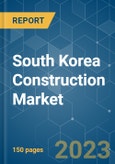Key Highlights
- COVID-19 had a significant impact on the construction industry in South Korea, with supply chain issues, a halt to planning and inspection timelines, and new measures to ensure worker health and safety.
- Following a 1.4% decline in 2020, the South Korean construction industry contracted by 1.4% in 2021. The downward revision was due to increased COVID-19 infection rates, a drop in construction output in the first three quarters of 2021, and disruptions in construction activity.
- The construction industry's value add decreased by 0.9% year on year (Y-o-Y) in real terms in the third quarter of 2021, according to the Korean Statistical Information Service (KOSIS), following a decline of 3.4% in the second quarter and growth of 3.2% in the first.
- In February 2021, the government announced that it would build 830,000 houses across the country over the next four years, with 323,000 in Seoul and 293,000 in nearby Gyeonggi Province and Incheon.
- In 2022, the industry recovered, growing by 4.1%, due to significant spending outlined in the proposed budget for 2022 and the implementation of planned energy projects.
South Korea Construction Market Trends
Increase in Construction Permits Driving the Market
The vast majority of the 232,000 construction permits issued in South Korea in 2021 were used for residential and commercial buildings. They are far ahead of other permit uses, with 82,860 and 85,100 permits, respectively. Educational and social use buildings received the fewest building permits, with only 8,527 issued.In total, 545,400 housing construction permits were issued in South Korea in 2021. About 45% of housing construction permits were for homes ranging in size from 60 to 85 sq m.
With over 186,000 housing units, Gyeonggi province had the most housing construction permits in South Korea.
In total, there were 17,000 unsold housing units in South Korea in 2021, down from around 19,000 the year before. With over 4,300 unsold housing units, Gyeongnam province had the highest number of unsold housing units among South Korea's metropolitan cities and provinces that year.
The total cost of general construction in South Korea in 2020 amounted to around USD 186.7 billion. The sector dealing with site preparation and foundation work had the highest costs in the specialized construction field, at around USD 39.8 billion.
Growth in the Real Estate Sector Boosting the Construction Industry
South Korea's real estate sector generated a gross domestic product (GDP) of around USD 110 billion in 2021. South Koreans regarded real estate as one of their most valuable investment assets.The number of commercial building transactions in South Korea in October 2021 was around 31,000, slightly down from around 34,000 the month before.
South Korea's commercial building stock reached 1.32 million units in 2020, up from 1.29 million the previous year. The number of commercial buildings in South Korea has steadily increased in the last decade.
With around 268,000 units, Gyeonggi province in South Korea had the most commercial buildings in 2020. With about 126,000 and 121,000 units, Seoul and Gyeongbuk came in second and third, respectively.
In 2020, South Korea had around 286 real estate investment trusts (REITs), up slightly from the previous year. In recent years, the number of REITs has steadily increased. The total assets of REITs amounted to around USD 50.18 billion in 2020, up from around USD 41 billion the previous year.
South Korea Construction Market Competitor Analysis
The report covers the major players operating in the South Korean construction market. The market is moderately fragmented, with some major players like Samsung C&T., Hyundai E&C, GS E&C, Daewoo E&C, etc. South Korea's local construction market has grown significantly, mainly due to a significant increase in private residential construction by contractors.Additional Benefits:
- The market estimate (ME) sheet in Excel format
- 3 months of analyst support
Table of Contents
Companies Mentioned (Partial List)
A selection of companies mentioned in this report includes, but is not limited to:
- Samsung C&T
- Hyundai E&C
- GS E&C
- Daewoo E&C
- POSCO E&C
- Daelim Industrial
- Hyundai Engineering
- Lotte E&C
- HDC (Hyundai Development Company)
- Hoban Construction








